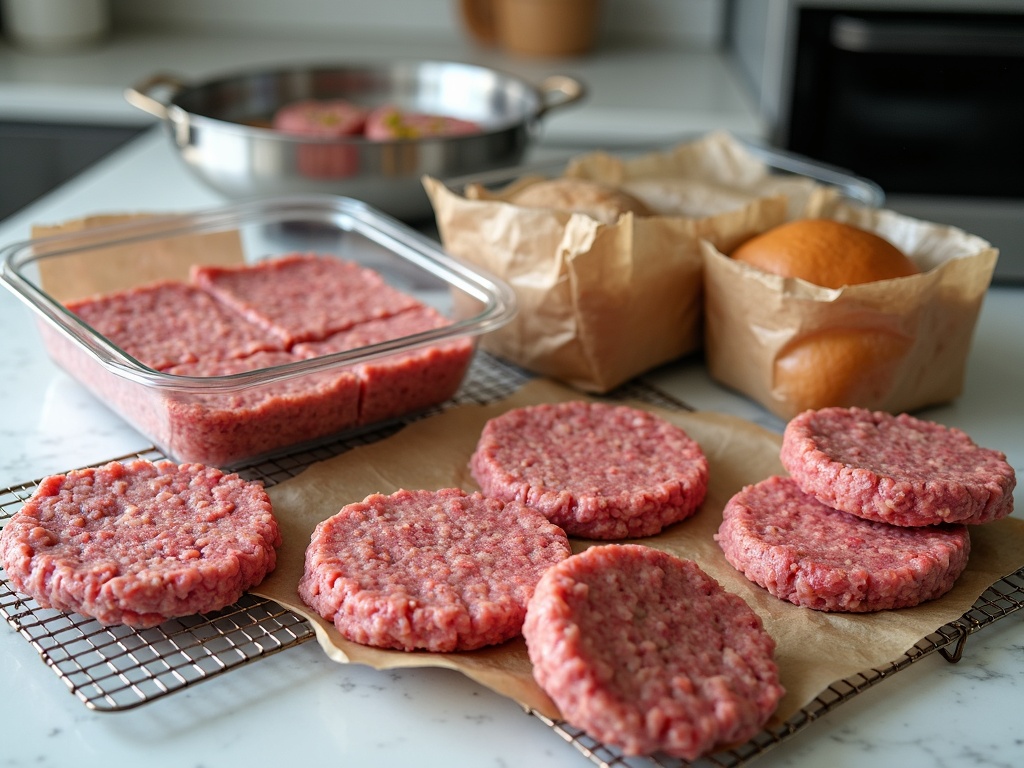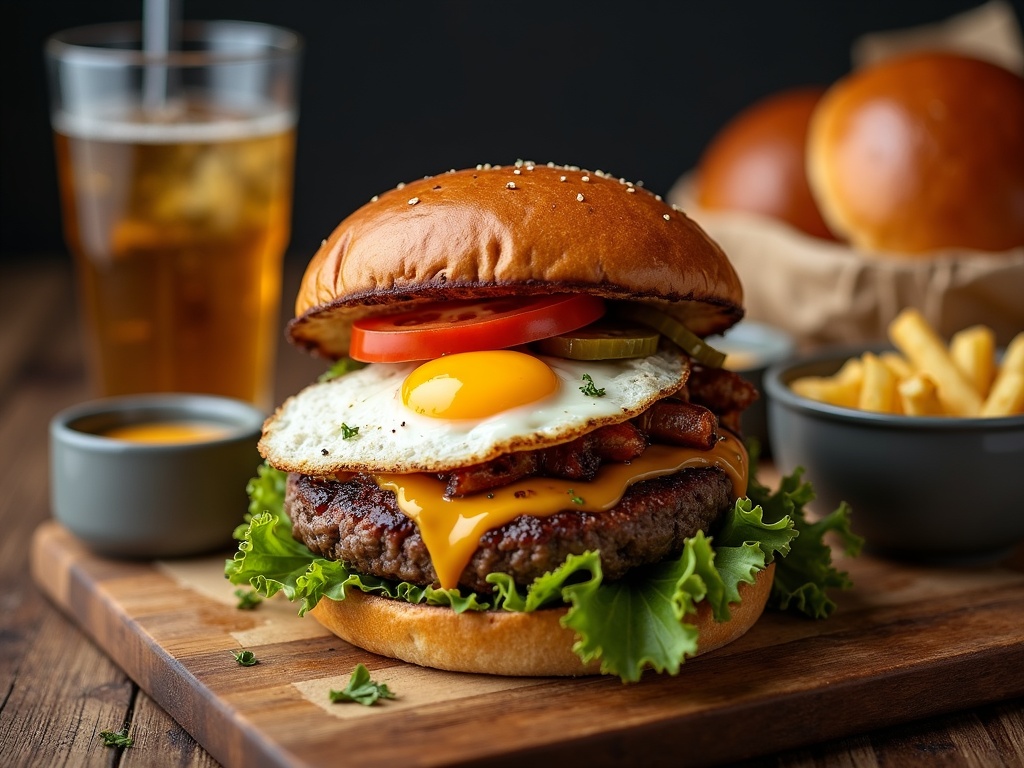Homemade burgers combine gourmet satisfaction with practical simplicity, giving me complete control over quality and flavor that beats fast food and many restaurant offerings. Making these juicy, customizable patties turns ordinary weeknight dinners into special occasions while delivering a delicious meal from kitchen to table in about 20 minutes.
Find In This Article
Key Takeaways
- Using ground beef with an 80/20 lean-to-fat ratio creates the perfect balance of flavor and juiciness in homemade burgers.
- Handle meat minimally when forming patties to maintain tenderness and create a dimple in the center to prevent puffing during cooking.
- Properly preheating your cooking surface and flipping the patties only once helps develop a flavorful crust while maintaining a juicy interior.
- Customization through toppings, condiments, and bun selection allows everyone to create their perfect burger experience.
- Proper storage techniques like separating components and wrapping patties correctly can extend freshness for days in the refrigerator or months in the freezer.
Why These Burgers Will Change Your Life
Homemade burgers have completely transformed my weeknight dinner routine, offering that perfect balance between gourmet satisfaction and practical simplicity. I’ve discovered that making burgers from scratch gives me control over quality and flavor that just can’t be matched by fast food or even many restaurants.
The Perfect Juicy Burger Experience
The magic starts with the meat. Using freshly ground beef with the right fat content (80/20 is my go-to) creates that mouthwatering juiciness that defines a great burger. I’ve found that gently handling the meat and forming loose patties preserves those pockets of fat that render during cooking, creating the ultimate juicy bite.
The customization options are practically endless. From classic cheese and lettuce to more adventurous toppings like caramelized onions, avocado, or even a fried egg, each burger becomes a canvas for personal expression. This flexibility makes homemade burgers perfect for pleasing everyone at the table—kids can keep it simple while adults can experiment with more complex flavor combinations.
For an even more impressive burger experience, try making smash burgers with their crispy, lacy edges and intensely beefy flavor. The technique couldn’t be simpler but delivers restaurant-quality results every time.
From Kitchen to Table in Minutes
One of the most life-changing aspects of homemade burgers is their efficiency. In just about 20 minutes, I can prep and cook a complete meal that satisfies even the hungriest family members. This speed doesn’t come at the expense of quality—these quick-cooking patties actually benefit from minimal handling and cooking time.
Here’s why burgers have become my go-to weeknight solution:
- They’re incredibly versatile and can fit any dietary need
- The basic ingredients are usually already in my kitchen
- They pair perfectly with simple sides like salad or chips
- Everyone can customize their own burger to their taste
- Leftovers can be repurposed into other ground beef recipes
I’ve found that keeping a package of ground beef in the freezer (which thaws quickly) along with some quality burger buns means I’m always prepared for an impromptu burger night. This readiness has saved countless evenings when time is tight but I still want to serve something that feels special and made with care.
Essential Ingredients for Success
Creating perfect homemade burgers starts with selecting the right ingredients. I’ve found that a thoughtful combination of quality components makes all the difference between an ordinary burger and one that rivals your favorite restaurant’s offering.
The Perfect Beef Blend
Ground beef with an 80/20 lean-to-fat ratio stands as the gold standard for homemade burgers. This proportion delivers the ideal balance of flavor and juiciness while maintaining structure when cooked. The fat content is crucial – too lean and your burgers will dry out, too fatty and they’ll shrink excessively. When selecting your meat, look for beef that appears bright red with white fat marbling throughout.
Learning how to cook ground beef properly is fundamental to burger success. I recommend bringing the meat to room temperature before forming patties, as cold meat contracts more during cooking, potentially leading to tough, dome-shaped burgers.
The seasoning approach for burgers should be simple yet purposeful. Salt and freshly ground black pepper form the foundation, but the magic happens with additions like Worcestershire sauce and garlic powder. Worcestershire adds depth with its complex umami notes, while garlic powder provides aromatic qualities without the moisture of fresh garlic.
Elevated Mix-ins and Accompaniments
To enhance your burger mixture, consider these optional add-ins that can transform your patties:
- Diced onions (preferably sautéed until translucent for sweetness)
- Fresh herbs like parsley or thyme for brightness
- A dash of smoked paprika for subtle smokiness
- Grated cheese folded into the meat mixture
- A few bread crumbs to help bind very wet ingredients
The bun selection deserves just as much consideration as the patty itself. Fresh burger buns should have structure to hold up to juicy patties without falling apart, yet remain soft enough to bite through easily. I prefer brioche buns for their buttery flavor, but potato rolls and pretzel buns offer delicious alternatives.
For those seeking variety, exploring different ground beef recipes can provide inspiration for your burger creations. The techniques and flavor combinations from other dishes can often translate beautifully to burgers.
If you’re feeling adventurous, try crafting smash burgers instead of traditional thick patties. This technique creates a delicious crust through direct contact with a scorching hot surface while keeping the interior juicy.
The beauty of homemade burgers lies in their flexibility. Once you’ve mastered the basics, you can customize to suit any preference. Some people swear by mixing multiple meat types (like adding ground chuck or brisket), while others keep it simple with premium ground beef and minimal handling.
Remember that handling the meat mixture minimally preserves tenderness. Overworking the meat activates proteins that can make your burgers tough. I gently form patties without packing them tightly, and always press a small dimple in the center with my thumb to prevent the dreaded burger dome during cooking.
With these quality ingredients and thoughtful techniques, your homemade burgers will deliver restaurant-quality results right from your kitchen. The right combination of meat, seasonings, and accompaniments creates burgers that are juicy, flavorful, and perfectly suited to your personal taste preferences.
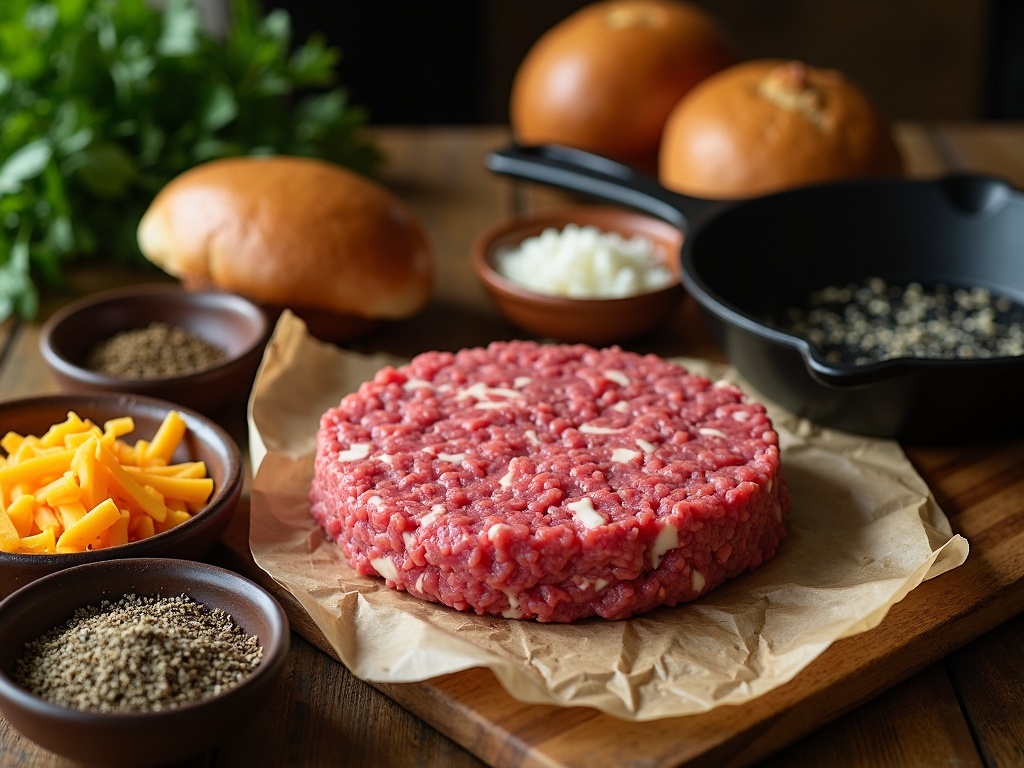
Crafting Your Perfect Patty
The foundation of any great homemade burger lies in how you prepare the patty. I’ve discovered that the perfect patty requires attention to detail in both preparation and handling. When you master these techniques, you’ll create juicy, flavorful burgers that rival your favorite restaurant.
Gentle Mixing for Maximum Tenderness
Handling your ground beef with care makes a remarkable difference in the final texture. When mixing ingredients into your meat, use a light touch and work the mixture just until combined. Overworking creates tough, dense burgers that lack the tender bite we all crave. I recommend using your fingertips rather than your full hand to incorporate seasonings and other ingredients.
For the best results, try these simple but effective techniques:
- Mix in seasonings with a fork instead of kneading with hands
- Fold ingredients together gently rather than squeezing or pressing
- Stop mixing as soon as ingredients are evenly distributed
- Allow the meat to sit for 10–15 minutes after mixing to let flavors meld
Shaping and Seasoning for Success
When forming patties, make them approximately 1/2 inch larger than your buns since they’ll shrink during cooking. I’ve found that creating a thumb impression in the center of each patty prevents the “puffing” that often happens during cooking, giving you an evenly cooked smash burger that’s delicious and perfectly shaped.
Season your patties generously with salt and pepper on both sides just before cooking. This simple seasoning allows the natural flavor of the beef to shine through while enhancing its natural savoriness.
Don’t forget to let your patties rest at room temperature for about 15–20 minutes before cooking. Cold meat straight from the refrigerator won’t cook evenly, often resulting in burgers that are charred outside but undercooked inside. This rest period allows for even cooking and better flavor development in your homemade ground beef creations.
The patty is just the beginning of your burger journey, but getting it right sets the foundation for everything that follows. With these techniques, you’ll create consistently juicy, flavorful burgers that will have everyone asking for your secret.
Grilling Your Way to Perfection
Getting that perfect char on your homemade burgers requires proper grilling technique. I’ve found that mastering a few simple steps transforms ordinary burgers into mouthwatering masterpieces that rival any restaurant offering.
First, I always preheat my grill to medium-high heat before cooking begins. This crucial step ensures those beautiful grill marks and prevents the meat from sticking. A properly heated grill (around 375-450°F) creates that initial sear that locks in juices, giving you the perfect balance between a crispy exterior and juicy interior.
Once the grill has reached the proper temperature, I place my formed patties on clean, oiled grates. Brushing a thin layer of oil on the grates creates a non-stick surface and enhances those distinctive grill marks. Don’t crowd the patties – they need breathing room to cook evenly and allow for easy flipping.
Timing and Temperature
Patience is key when grilling burgers. I flip the patties only once during cooking, typically after 3-5 minutes depending on thickness. Over-flipping disrupts the cooking process and can lead to dry, crumbly ground beef burgers. A single flip allows each side to develop that delicious caramelized crust.
For food safety, I always check the internal temperature with a meat thermometer. Ground beef should reach 160°F to eliminate harmful bacteria. If you’re making smash burgers, they’ll cook more quickly due to their thinner profile, so keep a close eye on them.
Before serving, let your burgers rest for about 5 minutes. This resting period allows the juices to redistribute throughout the meat instead of spilling out when cut. The result? A juicier, more flavorful burger experience.
Once you’ve mastered basic burger grilling, you can experiment with different ground beef recipes and techniques. Try:
- Stuffing your patties with cheese
- Adding different spice blends
- Mixing in complementary ingredients like diced onions or jalapeños
Perfect grilling isn’t just about heat and timing – it’s about attention to detail and respect for the ingredients. With these techniques, your homemade burgers will become the highlight of any cookout or family dinner.
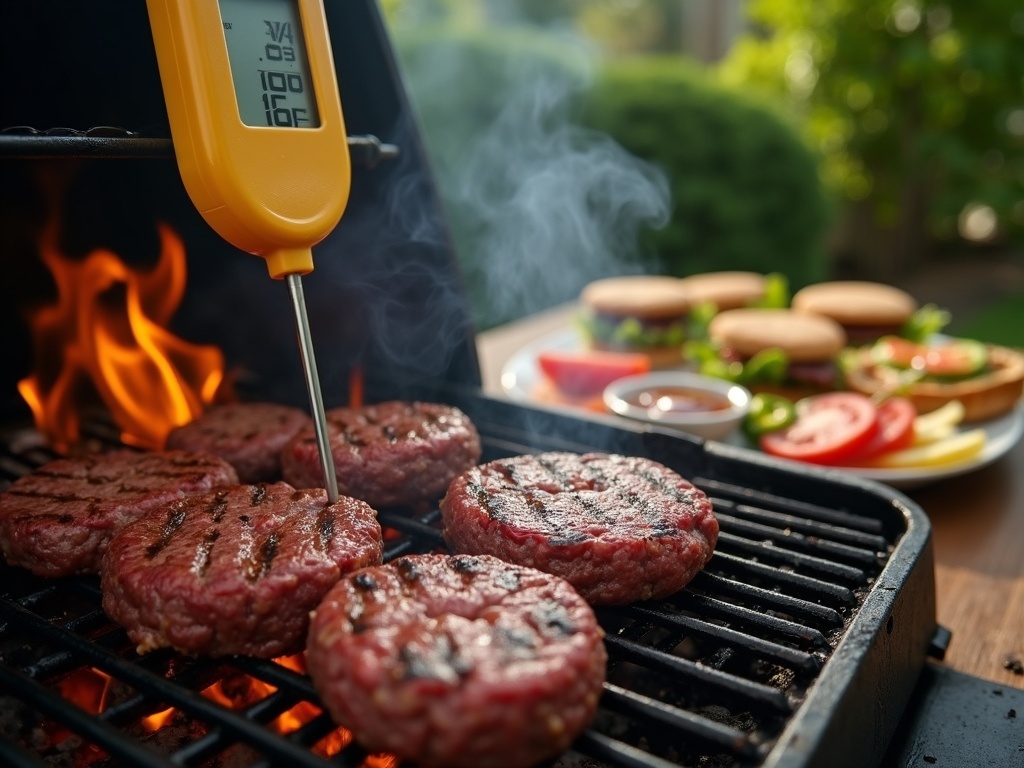
Common Mistakes That Ruin Burgers
I’ve made plenty of burger mistakes in my kitchen adventures, but I’ve learned from each one. Making the perfect homemade burger isn’t complicated, but there are several common errors that can take your patty from juicy and flavorful to dry and disappointing.
Meat Preparation Errors
Overworking the meat mixture is probably the biggest culprit behind tough, dense burgers. When you handle ground beef excessively, the proteins bind together too tightly, creating a texture more like meatloaf than a tender burger. Instead, I gently mix ingredients and form loose patties with minimal handling. This gentle approach ensures your smash burger recipe retains its juiciness.
Adding salt too early is another common mistake. Salt draws moisture from the meat, so mixing it in too far ahead of cooking can leave you with dry burgers. For best results, I only add salt to the outside of formed patties just before they hit the grill or pan. This simple timing adjustment makes a significant difference in the final texture.
Skipping the rest period might seem like a time-saver, but it’s actually sabotaging your burger’s flavor. After forming patties, let them rest in the refrigerator for about 30 minutes. This rest allows the fat to firm up and the flavors to develop. Your patience will be rewarded with a more cohesive patty that won’t fall apart during cooking.
Cooking Technique Mistakes
Pressing patties while cooking is tempting – especially when you hear that satisfying sizzle. However, each press squeezes out precious juices that should stay in your burger. When learning how to cook ground beef for burgers, remember that patience is key. Let the patty cook undisturbed to retain its moisture.
Flipping too frequently is another habit that leads to subpar results. For a proper sear and even cooking, flip once and only once. When working with ground beef recipes, a single flip allows each side to develop a flavorful crust while maintaining a juicy interior.
I’ve found that using a meat thermometer removes the guesswork from determining doneness. For medium burgers, aim for an internal temperature of 160°F. This ensures food safety without overcooking.
By avoiding these common pitfalls, I’ve dramatically improved my homemade burgers. These simple adjustments don’t require fancy equipment or ingredients – just attention to technique. Your perfect burger is just a few mindful steps away.
Must-Have Toppings and Condiments
Creating the perfect homemade burger goes beyond just cooking a delicious patty. The toppings and condiments you choose can elevate your burger from good to extraordinary. I’ve compiled essential additions that will transform your smash burger at home into a gourmet experience.
Essential Burger Toppings
Nothing beats the perfect slice of cheese melting over a hot patty. American cheese offers that classic melt-in-your-mouth quality we all love, while sharp cheddar brings a more pronounced flavor. For something different, try Swiss for its nutty taste or pepper jack for a spicy kick. Blue cheese crumbles can add an unexpected tangy punch that pairs wonderfully with beef.
Fresh vegetables add necessary texture and brightness to cut through the richness of the meat. Crisp iceberg lettuce provides the perfect crunch, while romaine offers a more substantial bite. For tomatoes, look for ripe beefsteak or heirloom varieties sliced about ¼-inch thick for the perfect juiciness without making your bun soggy.
Onions come in various forms, each bringing unique character to your burger:
- Raw red onions add a sharp, colorful bite
- Yellow onions, when grilled or caramelized, contribute sweetness
- Crispy fried onions provide texture and concentrated flavor
- Quick-pickled onions deliver acidity to balance the richness of the perfectly cooked ground beef
Pickles deserve special attention as they provide crucial acidity. Dill pickles are the classic choice, but bread and butter pickles add sweetness alongside their tang. For the adventurous, try:
- Pickled jalapeños
- Pickled red onions
- Pickled green tomatoes for a Southern twist
Signature Sauces and Spreads
The sauce can become your burger’s signature element. While store-bought condiments work in a pinch, homemade options take your creation to another level.
My go-to special sauce combines:
- ½ cup mayonnaise
- 2 tablespoons ketchup
- 1 tablespoon yellow mustard
- 1 teaspoon pickle relish
- A dash of smoked paprika
This creates that perfect “secret sauce” that makes fast-food burgers so addictive.
Don’t limit yourself to the classics, though. I’ve found these creative options can make your burgers memorable:
- Garlic aioli: Mix mayo with roasted garlic, lemon juice, and black pepper
- Sriracha mayo: Combine mayo with sriracha sauce for heat with creaminess
- Truffle aioli: A small amount of truffle oil mixed into mayo creates luxury
- Herb butter: Compound butters with herbs melt beautifully into hot patties
When assembling your burger, remember that order matters. I place sauce on both bun halves, then lettuce on the bottom (it prevents the bottom bun from getting soggy). The patty comes next, followed by cheese and then the remaining toppings.
For a truly next-level experience, consider toasting your buns with butter. This creates a barrier against moisture and adds flavor and texture contrast.
The beauty of homemade burgers is customization. I encourage you to experiment with different ground beef recipe combinations to find your perfect stack. Try unexpected additions like:
- Thinly sliced avocado
- A fried egg with a runny yolk
- Potato chips for added crunch
When serving burgers for a group, setting up a toppings bar allows everyone to customize their creation. Just make sure to provide both classic options and a few surprising elements to keep things interesting.
Pro Tips for Better Burgers
Creating standout homemade burgers isn’t complicated, but there are several key techniques that separate an ordinary burger from an extraordinary one. I’ve found that focusing on a few critical elements can transform your backyard cookout into a gourmet experience.
Starting With Quality Ingredients
The foundation of any great burger begins with selecting quality meat. I recommend choosing ground beef with a fat content between 15-20% (often labeled as 80/20 or 85/15). This ratio provides the perfect balance of flavor and juiciness while preventing the burger from drying out during cooking.
For truly exceptional results, consider these meat options:
- Freshly ground chuck from your local butcher
- A custom blend combining sirloin, brisket, and short rib
- Grass-fed beef for a more distinctive flavor profile
Once you’ve selected your meat, keeping all ingredients cold is absolutely crucial. I always refrigerate my ground beef until I’m ready to form patties, and sometimes even chill the mixing bowl beforehand. Cold meat prevents the fat from melting prematurely, which is key to maintaining those flavorful pockets that make burgers juicy when cooked.
When it’s time to form your patties, resist the urge to overwork the meat. I gently shape loose patties with minimal handling, which creates a more tender texture in the finished burger. Tightly packed meat results in dense, tough burgers that lack the desired texture. I’ve found making a slight dimple in the center of each patty prevents the burger from puffing up in the middle while cooking.
Mastering Cooking Techniques
Temperature control is the secret to perfectly cooked burgers. I preheat my grill to medium-high heat (around 375-450°F) before adding patties. This initial sear locks in juices while creating that coveted caramelized crust. For thicker patties, I’ll sometimes move them to a cooler part of the grill to finish cooking without burning.
For those seeking the distinctive crust found in restaurant burgers, try the smash burger technique, where the patty is pressed firmly onto a scorching hot surface. This maximizes the delicious Maillard reaction that creates complex flavors.
Don’t neglect your burger buns! I always toast them lightly during the final minute of cooking—either on the cooler side of the grill or in a buttered skillet. This simple step prevents soggy buns and adds another layer of texture and flavor. I sometimes brush the cut sides with olive oil or melted butter before toasting for extra richness.
The timing of your toppings matters too. Adding cheese? Place it on the patty during the final minute of cooking, then cover briefly to help it melt perfectly. For those looking to expand their burger horizons, exploring different ground beef recipes can provide inspiration for unique flavor combinations.
Remember that resting your cooked patties for 2-3 minutes before serving allows juices to redistribute throughout the meat. While this might seem like an unnecessary step when you’re hungry, it makes a noticeable difference in the final burger’s juiciness.
Properly cooking ground beef to the right internal temperature is essential for both safety and flavor. I aim for 160°F for standard burgers, using an instant-read thermometer to check for doneness rather than cutting into the patty and losing precious juices.
By focusing on these fundamental elements—quality meat, temperature management, proper technique, and attention to detail—I consistently create burgers that rival those from high-end restaurants, right in my own backyard.
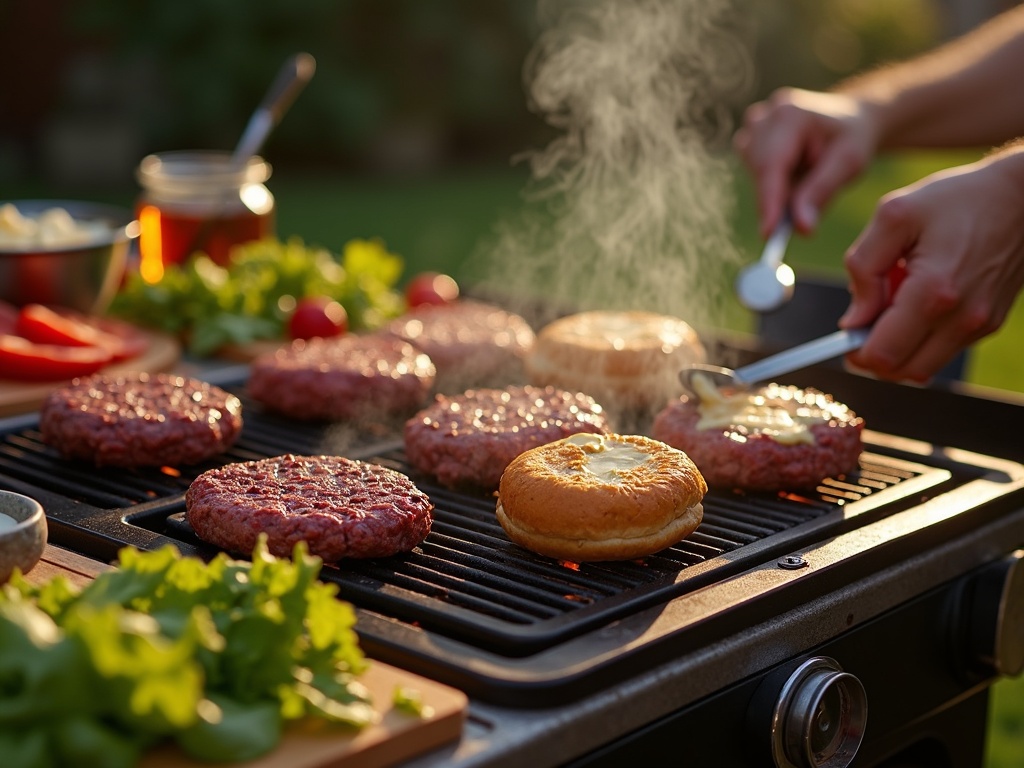
Storage and Leftovers
Properly storing homemade burgers keeps them flavorful and safe for later enjoyment. I’ve found that taking care with storage extends the life of these delicious meals and prevents food waste.
Refrigeration and Cooling
After cooking your juicy beef patties, allow them to cool at room temperature for no more than two hours before refrigeration. This timeframe is crucial for food safety.
For faster cooling:
- Separate larger batches into smaller portions
- Use shallow containers to increase surface area
- Leave the container lid slightly ajar until the burgers reach room temperature
Once properly cooled, store your burger patties in airtight containers or wrap them tightly in aluminum foil or plastic wrap. Cooked burger patties maintain their quality in the refrigerator for 3-4 days when stored at 40°F (4°C) or below.
For assembled burgers with toppings, I recommend storing components separately when possible. This prevents soggy buns and maintains the integrity of vegetables and condiments. If storing a fully assembled burger, wrap it tightly in parchment paper before placing it in an airtight container.
Freezing and Reheating
Freezing extends the life of your homemade burgers significantly. Both raw and cooked smash burger patties freeze well when properly prepared:
For raw patties:
- Place parchment paper between individual patties
- Wrap tightly in plastic wrap, then aluminum foil
- Store in a freezer-safe bag with air removed
- Label with the date (use within 3-4 months)
For cooked patties:
- Cool completely before freezing
- Wrap individually in parchment paper
- Place in freezer-safe bags or containers
- Use within 2-3 months for best quality
When it’s time to enjoy your frozen burger patties, thawing in the refrigerator overnight provides the safest method. For cooked patties that need reheating, I’ve found several effective approaches:
- In the oven: Preheat to 350°F (175°C), place patties on a baking sheet, and heat for 8-10 minutes.
- On the stovetop: Use a skillet over medium heat with a splash of water and cover to create steam, cooking for 3-5 minutes per side.
- In the microwave: Place on a microwave-safe plate and heat in 30-second intervals until warmed through (though this may affect texture).
For frozen raw patties, I recommend cooking directly from frozen by adding 2-3 minutes to your usual cook time. Always check that ground beef reaches an internal temperature of 160°F (71°C).
When reheating entire assembled burgers, disassemble if possible, heat the patty separately, and reassemble with fresh vegetables for the best eating experience.
Remember that repeatedly freezing and thawing increases food safety risks and degrades quality. Always use clean utensils when handling stored food and discard any burgers with an off smell or appearance. Proper storage techniques not only extend the life of your homemade burgers but also maintain their delicious flavor and texture for future meals.
